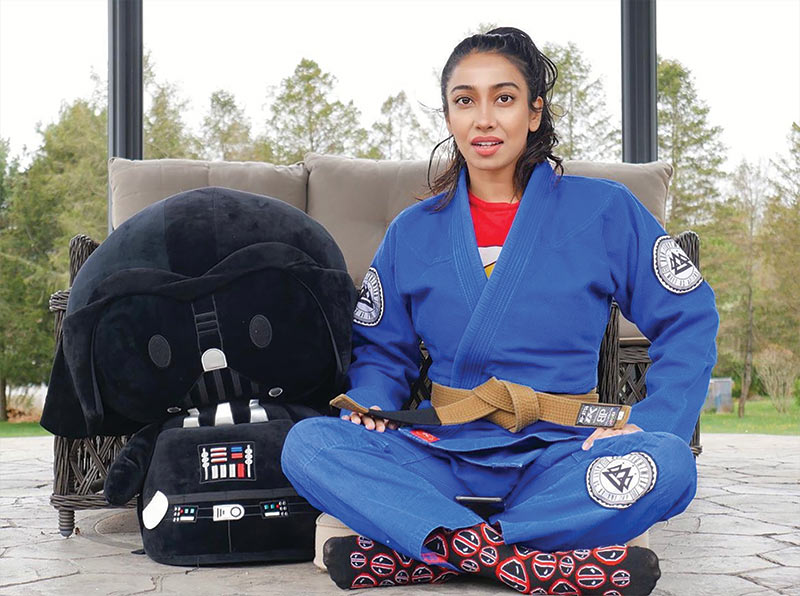Spirit Pilot ‘Grapples’ with New Role as MMA Reality TV Show Producer
By John Perkinson, Senior Staff Writer

F/O Nilofer Mallick (Spirit) has earned her brown belt in Brazilian Jiu Jitsu and is associate producer of ESPN’s The Ultimate Fighter.
While some airline pilots may opt to take a few self-defense courses to better protect the flight deck, F/O Nilofer Mallick (Spirit) is an expert in the field. Fascinated with mixed martial arts (MMA), she earned her Brazilian Jiu Jitsu brown belt, demonstrating the technical knowledge and skill for the second-highest ranking of this very specialized discipline.
For years, Mallick has trained for, competed, and sometimes even placed in events like the BJJ Fighter Submission Open, the Empire Submission Challenge, and the North American Grappling Association’s World Championship. However, she found a whole new way to apply her combative talents late last year when she became the associate producer of ESPN’s The Ultimate Fighter.
This popular reality series, which first aired in 2005, launched a global fascination with MMA sports. While the show has experienced several iterations, each season features 16 up-and-coming MMA athletes who receive world-class coaching while competing for the title of Ultimate Fighter. The winner gets a six-figure Ultimate Fighting Championship (UFC) contract.
While Mallick has only worked with the organization for a short time, The Ultimate Fighter has launched the careers of numerous UFC stars, including Kamaru Usman, Tony Ferguson, and TJ Dillashaw.
As the associate producer, Mallick researches and interviews potential candidates for the new season’s cast. “During filming, it’s a lot of monitoring and taking notes,” she remarked. “When you’re filming a reality show, you’re listening to conversations and looking for story angles. You want to add to the quality of the character development,” she said, noting that in telling the story, it’s important to highlight the authentic nature of each participant.
“I really like discovering good fighters who are still unknown, and that’s kind of the point of the program,” Mallick shared. “If they’re successful, you get to be a part of their story and help them realize their dreams.”
The Spirit pilot grew up in a close-knit family, with a father who was a general aviation pilot, a grandfather who loved wrestling, and another grandfather who had boxed in his native Pakistan. As evidence of their tremendous influence, Mallick was flying by the time she was 13 and began developing her MMA talents with friends she met in college.
Deciding to pursue a career in flying, Mallick attended FlightSafety International in Florida where she earned her ratings and eventually became a flight instructor. Years later, she was hired by CommuteAir and served as the pilot group’s Critical Incident Response Program, Human Intervention Motivation Study (HIMS), Aeromedical, and Pilot-to-Pilot chairs as well as a peer mentor. In 2021, she moved to Spirit Airlines.
The MMA community is also a close-knit family and through common acquaintances, Mallick eventually became friends with the executive producer of The Ultimate Fighter, Gary DeFranco. The two occasionally met to discuss ideas for the program on an informal level. Meanwhile, a setback for Mallick introduced an interesting opportunity.
“I recently sustained a fairly significant injury while training in the gym. I was grounded for a while because I needed to have surgery,” she said. “Gary heard about my situation and suggested I take on an official role with The Ultimate Fighter as the program’s associate producer.” Mallick couldn’t wait to get started.
“Many see martial arts fighting as savage and brutal,” observed Mallick. “They don’t understand that this isn’t a street fight; it’s a sport. It takes a tremendous amount of fortitude and mental capacity. If you’re going to be successful in this sport, you have to be cerebral about it, and that’s very difficult to do in the heat of the moment when fists and feet are flying at you.”
Mallick finds it particularly impressive to watch participants develop strategies and then train to make these tactics second nature. “In many respects, it’s a lot like what we do on the flight deck,” she said. “Your opponent in this case becomes the challenging situation you confront. But whether flying or fighting, it’s important to be able to weigh your alternatives and make decisive, timely decisions.”
Learn more about The Ultimate Fighter.

